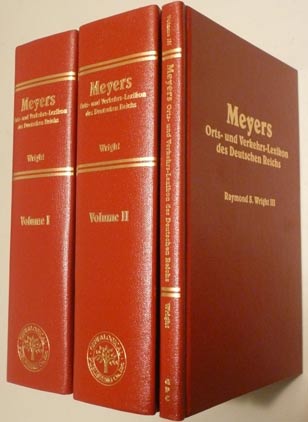 Meyers Orts (for short) is perhaps one of the most well know and famous of all gazetteers. Those searching their German ancestry have no doubt heard of it. Some have said, “Almost all serious German research begins with Meyers Orts.” The Gazetteer, first printed in 1912, covers approximately 210,000 cities, towns, hamlets, and dwelling places in the German Empire prior to World War I. The book is still available to individuals and libraries under the title Meyers Orts- und Verkehrs-Lexikon des Deutschen Reichs: With Researcher’s Guide and Translation of the Introduction, Instruction for the Use of the Gazetteer, and Abbreviations, by Raymond S Wright III.
Meyers Orts (for short) is perhaps one of the most well know and famous of all gazetteers. Those searching their German ancestry have no doubt heard of it. Some have said, “Almost all serious German research begins with Meyers Orts.” The Gazetteer, first printed in 1912, covers approximately 210,000 cities, towns, hamlets, and dwelling places in the German Empire prior to World War I. The book is still available to individuals and libraries under the title Meyers Orts- und Verkehrs-Lexikon des Deutschen Reichs: With Researcher’s Guide and Translation of the Introduction, Instruction for the Use of the Gazetteer, and Abbreviations, by Raymond S Wright III.
The Gazetteer was originally published to assist government and economic entities and representatives in identifying public services, governmental agencies, educational and religious institutions, and transportation and business facilities in each of the thousands of communities. The book even claims it provides heading for all named dwelling places in the German Empire.
Throughout this vast work locality entries are arranged alphabetically and describe each place in terms of the type of community it is (city, village, hamlet, etc.) and the civil, court, military, and religious jurisdictions under which it falls. An understanding of these several jurisdictions will assist researchers in their efforts to find original records that are housed today in church or government offices and archives. Describing these jurisdictions is a crucial as well as significant part of of the researcher’s guide written by Wright.
Raymond S Wright III is a professor at Brigham Young University. His contributions have made this difficult to read book truly accessible to the everyday family historian
Meyers Orts comes as a three volume set, with a total 2,390 pages. Whether the claim that every dwelling place in the Empire is listed is true or not, this is clearly and exhaustive work that has stood the test of time as a key resource for those researching their German ancestry. “This reprint edition includes a third volume consisting of the often-omitted Appendix to Volume II and the scarce Supplement of September 1913. Thus a rare and indispensable work, encompassing thousands of pages and dozens of maps–previously found in only a handful of American libraries–is not only available to researchers but is now a practical research tool.”
The Researcher’s Guide Covers:
Scope and Purpose
- Unlisted Localities
Understanding Entries in the Meyers Gazetteer
- How to Read the Gothic Typeface Used in Locality Entries
- Abbreviations and Punctuations
Using Meyers to Find Records in Archives, Record Offices, and Libraries
- National, State, and Local Records
- Religious Jurisdictions
- State, Provinces, and Districts in Meyers Orts- und Verkehrs-Lexikon
- Government Records of Births, Marriages, and Deaths
- Courts
- Military Records
- Cities, Town, and Villages
- Private Jurisdictions
- Summary
The Introduction Covers:
[An] Introduction
Instruction for the Use of the Gazetteer
- Arrangement of Locality Entries
- Arrangement of the Content within Locality Entries
Copies of this massive three volume set, Meyers Orts- und Verkehrs-Lexikon des Deutschen Reichs: With Researcher’s Guide and Translation of the Introduction, Instruction for the Use of the Gazetteer, are available to individuals and to libraries from Family Roots Publishing. Price: $294.00.
Also note that the above set of books (less the third supplemental volume) is available at Ancestry.com.
Apart from the informaiton contained within the researcher’s guide, other guides are also available. One suggested reading is Understanding Meyers Orts: Translating Guide for the Directory of the Towns and Places in the German Empire. [Click here to read a review]